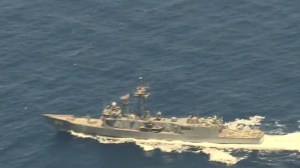Egypt has deployed a submarine to the Mediterranean Sea to search for the so-called black boxes from EgyptAir Flight 804, President Abdel Fattah el-Sisi said Sunday.

Searchers have recovered parts of the plane wreckage — passengers’ personal belongings, life vests, aircraft chairs and even body parts — but are still scouring the Mediterranean for the fuselage and flight data and cockpit voice recorders that would likely reveal what went wrong on the flight.
The Egyptian military said it spotted the debris about 290 kilometers (180 miles) north of Alexandria, Egypt.
The submarine can reach a depth of 3,000 meters (about 9,800 feet), Egyptian TV reported.
No survivors have been found, and authorities have not said what caused the plane with 66 people aboard to crash into the sea early Thursday en route from Paris to Cairo.
On Thursday, Egyptian Civil Aviation Minister Sharif Fathi said the chances of an act of terror causing the crash were higher than those of a mechanical failure.
But he was more cautious Sunday, urging the media not to jump to conclusions or speculate about what caused the crash.
“In cases like this we need to wait until we base our judgment on facts,” Fathi said in an interview with CNN’s Becky Anderson. “We cannot at this stage come up with any conclusion.”
French Foreign Minister Jean-Marc Ayrault told passengers’ families Saturday that “no theory” has been ruled out. No group has claimed responsibility for the crash.
Ongoing operation
The Airbus A320 was carrying 56 passengers and 10 crew members and security when it left Charles de Gaulle Airport in Paris late Wednesday. The plane disappeared from radar early Thursday as it flew to Cairo in what should have been about a 3½-hour flight.
At some point before dropping off radar, the plane swerved 90 degrees to the left and then made a 360-degree turn to the right before plunging first to 15,000 feet, then 10,000 feet, and disappearing from radar, Greek officials said.
Thirty of the passengers were Egyptian.
Also aboard were 15 French citizens, including an infant, and passengers from Iraq, Britain, Belgium, Kuwait, Saudi Arabia, Sudan, Chad, Portugal, Canada and Algeria, said Fathi, Egypt’s civil aviation minister.
Automatic messages about smoke
French aviation officials revealed Saturday that the plane sent automatic messages about smoke in the front of the aircraft just before it crashed.
France’s revelation confirmed flight data that CNN obtained from an Egyptian source. That flight data indicated smoke alerts occurred near the cockpit minutes before the crash.
The data came through the Aircraft Communications Addressing and Reporting System, or ACARS, which sends messages between planes and ground facilities. A screen grab of data has time stamps that match the approximate time the aircraft went missing.
There were indications of problems with a heated window in the cockpit, a sliding window in the cockpit, smoke in the lavatory, smoke in the avionics compartment below the cockpit, a fixed window, the autopilot and the flight control system.
The alerts don’t necessarily mean a fire occurred on the plane or that the crew even knew about the alerts, which are automatically transmitted, aviation experts cautioned.
There have been electrical problems with window anti-ice heaters in A320s. In 2003, the Federal Aviation Administration required windshields replaced in all A320s in the United States. It’s not known whether Egypt followed the FAA directive.
As of now, investigators have found nothing implicating the flight crew or security officials aboard the plane, an Egyptian official said.
Checks of the passenger manifest have so far resulted in no hits on terror watch lists, officials with knowledge of the investigation said.
The jet had routine maintenance checks in Cairo before it left for Paris, the airline said. Earlier Wednesday, the jet was also in Eritrea and Tunisia, data from flight-tracking websites show.
The search
Greece, France, the United States and other nations were searching about 130 nautical miles southeast of the Greek island of Karpathos, Greek aviation officials said.
The European Space Agency said that its Sentinel-1A satellite had spotted an oil slick near where the plane is believed to have crashed. The agency said it’s possible the slick could be from another source.
The airline said it will take time to retrieve body parts and conduct DNA tests. Families were asked to provide as much information as possible to identify the body parts. Debris and body parts will be taken to a military base and then to Cairo International Airport.
The Egyptian Civil Aviation Ministry has formed an investigative committee for the crash led by Ayman al-Moqadem, the investigator also in charge of the inquiry into the October crash of a Russian Metrojet airliner over the Sinai.
That disaster, which killed all 224 aboard, is widely believed to be the work of terrorists.















